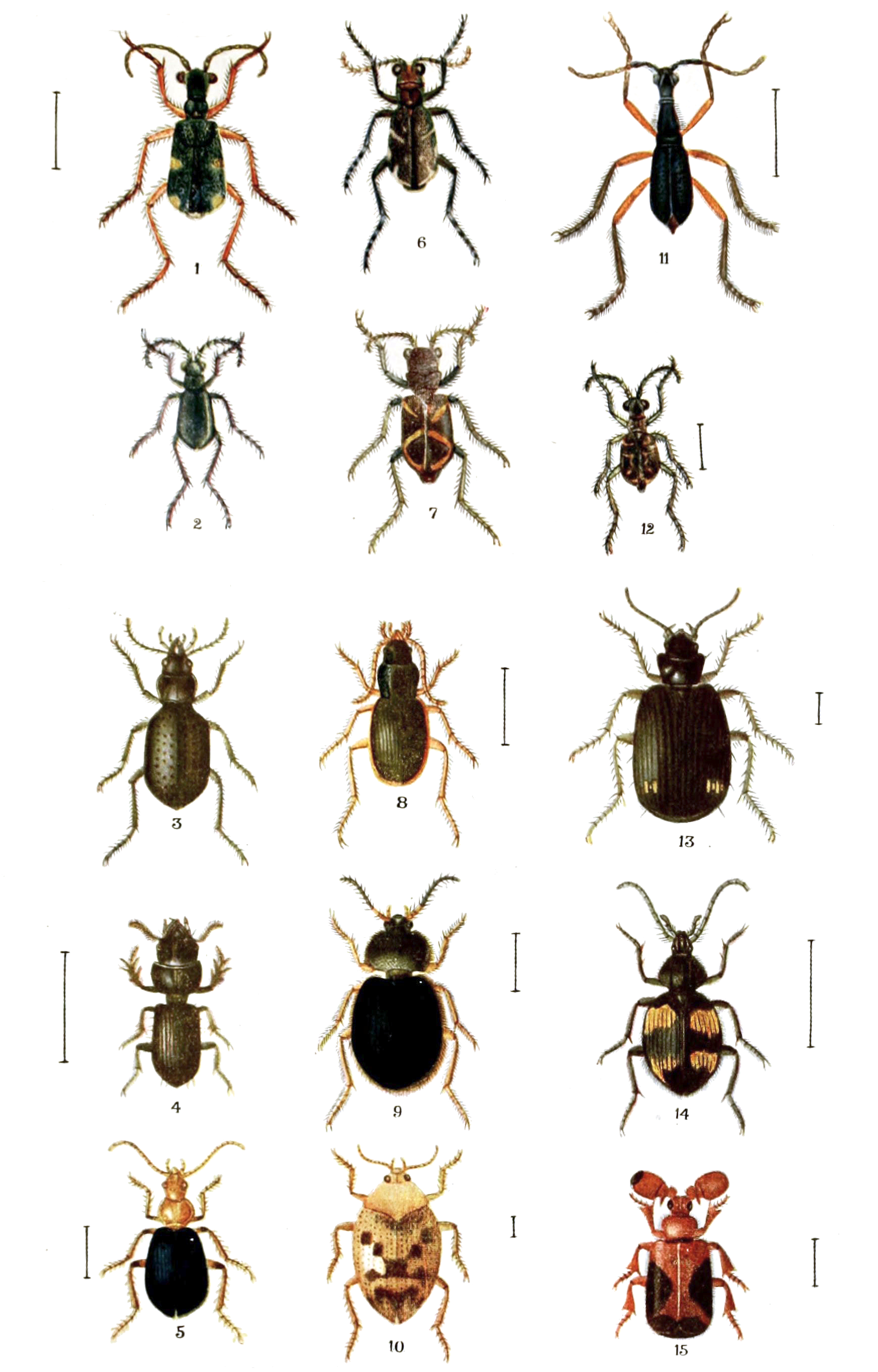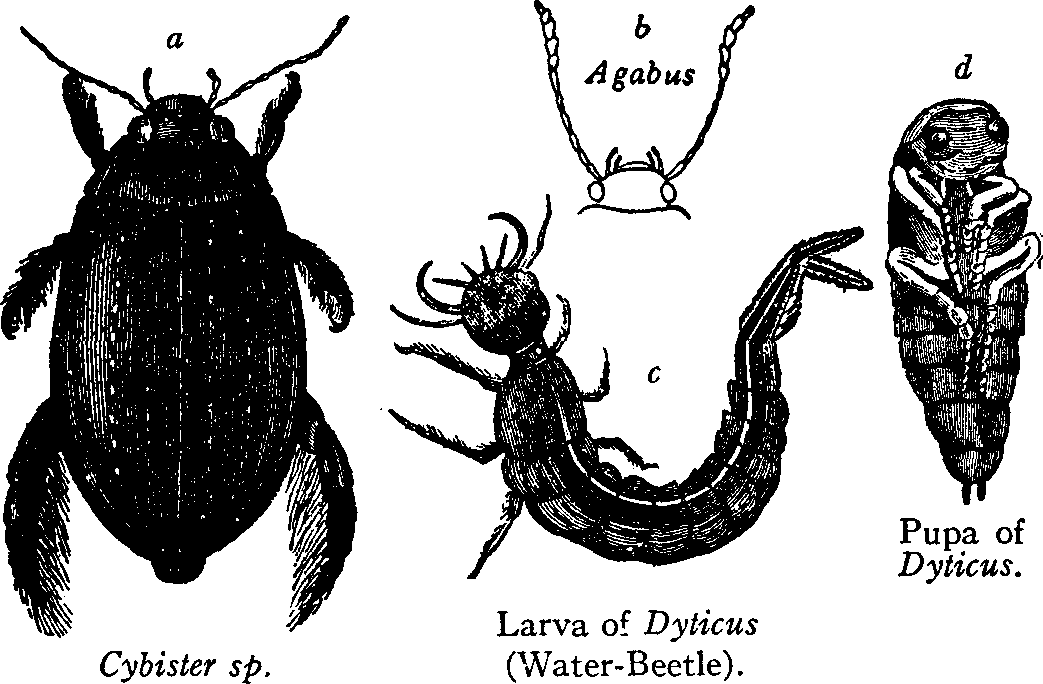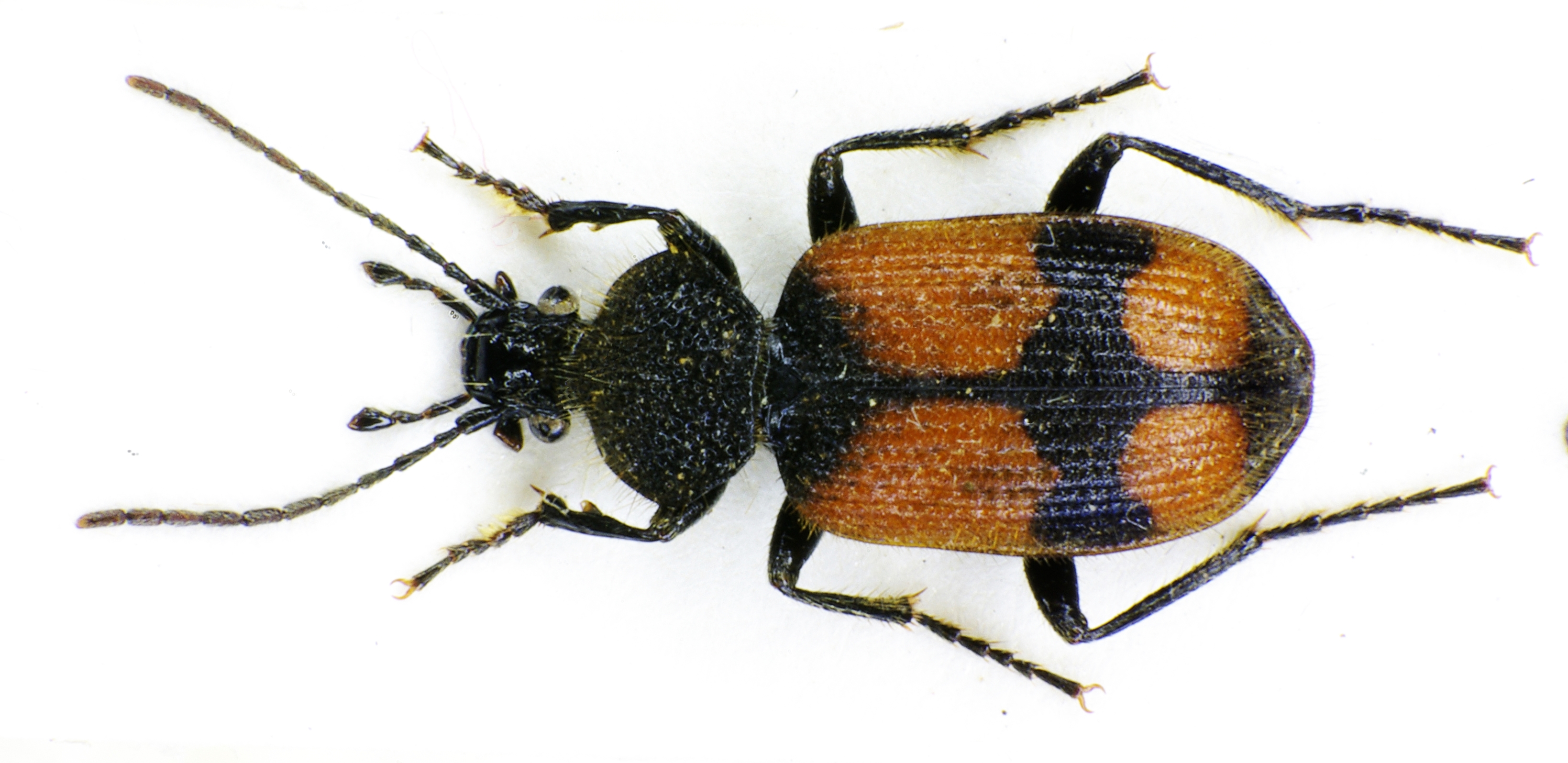|
Gyrinidae
The whirligig beetles are water beetles, comprising the family Gyrinidae, that usually swim on the surface of the water if undisturbed, though they swim underwater when threatened. They get their common name from their habit of swimming rapidly in circles when alarmed, and are also notable for their divided eyes which are believed to enable them to see both above and below water. (View wiki description) The family includes some 700 extant species worldwide, in 15 genera, plus a few fossil species. Most species are very similar in general appearance, though they vary in size from perhaps 3 mm to 18 mm in length. They tend to be flattened and rounded in cross section, in plain view as seen from above, and in longitudinal section. In fact their shape is a good first approximation to an ellipsoid, with legs and other appendages fitting closely into a streamlined surface. Whirligig beetles belong to the beetle suborder Adephaga, which also includes Ground beetle, ground beet ... [...More Info...] [...Related Items...] OR: [Wikipedia] [Google] [Baidu] |
Gyrininae
Gyrininae is a subfamily of ground and water beetles in the family Gyrinidae. There are at least 740 described extant species in Gyrininae. Genera Taxonomy after * Dineutini ** ''Cretodineutus'' - Burmese amber, Late Cretaceous (Cenomanian) ** ''Cretogyrus'' - Burmese amber, Cenomanian ** ''Dineutus'' ** ''Enhydrus'' ** ''Macrogyrus'' (including ''Andogyrus'' ) ** ''Mesodineutes'' - Darmakan Formation, Russia, Danian ** ''Miodineutes'' - Germany, Miocene ** ''Porrorhynchus'' * Gyrinini ** ''Aulonogyrus'' ** ''Gyrinoides'' ** ''Gyrinus'' ** ''Metagyrinus'' * Orectochilini ** ''Gyretes'' ** ''Orectochilus'' ** ''Orectogyrus'' ** ''Patrus'' * ''Chimerogyrus'' - Burmese amber, Cenomanian References * Lawrence, J. F., and A. F. Newton Jr. / Pakaluk, James, and Stanislaw Adam Slipinski, eds. (1995). "Families and subfamilies of Coleoptera (with selected genera, notes, references and data on family-group names)". ''Biology, Phylogeny, and Classification of Coleopt ... [...More Info...] [...Related Items...] OR: [Wikipedia] [Google] [Baidu] |
Adephaga
The Adephaga (from Greek ἀδηφάγος, ''adephagos'', "gluttonous") are a suborder of beetles, and with more than 40,000 recorded species in 10 families, the second-largest of the four beetle suborders. Members of this suborder are collectively known as adephagans. The largest family is Carabidae (ground beetles) which comprises most of the suborder with over 40,000 species. Adephaga also includes a variety of aquatic beetles, such as predaceous diving beetles and whirligig beetles. Anatomy Adephagans have simple antennae with no pectination or clubs. The galeae of the maxillae usually consist of two segments. Adult adephagans have visible notopleural sutures. The first visible abdominal sternum is completely separated by the hind coxae, which is one of the most easily recognizable traits of adephagans. Five segments are on each foot. Wings The transverse fold of the hind wing is near the wing tip. The median nervure ends at this fold, where it is joined by a ... [...More Info...] [...Related Items...] OR: [Wikipedia] [Google] [Baidu] |
Spanglerogyrus
''Spanglerogyrus albiventris'' is a species of beetle in the family Gyrinidae The whirligig beetles are water beetles, comprising the family Gyrinidae, that usually swim on the surface of the water if undisturbed, though they swim underwater when threatened. They get their common name from their habit of swimming rapidly ..., the only species in the genus ''Spanglerogyrus''. It is native to North America, and was described in 1979 from specimens found in southern Alabama. It is the only living member of the subfamily Spanglerogyrinae, the earliest diverging extant lineage of the gyrinids which also includes '' Angarogyrus'' from the Jurassic and Cretaceous of Asia. References Gyrinidae Monotypic Adephaga genera {{Gyrinidae-stub ... [...More Info...] [...Related Items...] OR: [Wikipedia] [Google] [Baidu] |
Heterogyrus
''Heterogyrus milloti'' is a species of beetle in the family Gyrinidae, the only species in the genus ''Heterogyrus''. It is endemic Endemism is the state of a species being found only in a single defined geographic location, such as an island, state, nation, country or other defined zone; organisms that are indigenous to a place are not endemic to it if they are also foun ... to Madagascar, and forms a basal lineage within the family, estimated to have diverged from all other gyrinids (aside from the even earlier branching '' Spanglerogyrus'') 200 million years ago. It is suggested to be closely related to the fossil genera '' Mesogyrus, Cretotortor'' and '' Baissogyrus'' which constitute the subfamily Heterogyrinae. References Gyrinidae Monotypic Adephaga genera {{Gyrinidae-stub ... [...More Info...] [...Related Items...] OR: [Wikipedia] [Google] [Baidu] |
Dytiscidae
The Dytiscidae, from the Ancient Greek word δυτικός (''dystikos''), meaning "able to dive", are the predaceous diving beetles, a family of water beetles. They occur in virtually any freshwater habitat around the world, but a few species live in terrestrial habitats such as among leaf litter. The “diving” in their common name comes from their cycling between underwater and the surface to replenish oxygen like a diver. The adults of most are between long, though much variation is seen between species. The European '' Dytiscus latissimus'' and Brazilian '' Bifurcitus ducalis'' are the largest, reaching up to respectively, although the latter is listed as extinct by the IUCN. In contrast, the smallest is likely the Australian '' Limbodessus atypicali'' of subterranean waters, which only is about long. Most are dark brown, blackish, or dark olive in color with golden highlights in some subfamilies. The larvae are commonly known as water tigers due to their voracious appe ... [...More Info...] [...Related Items...] OR: [Wikipedia] [Google] [Baidu] |
Gyrinus Head1
''Gyrinus'' is a genus of small aquatic whirligig beetles in the family Gyrinidae native to the Palearctic (including Europe), the Near East, the Nearctic, North Africa, Asia and Australia Australia, officially the Commonwealth of Australia, is a country comprising mainland Australia, the mainland of the Australia (continent), Australian continent, the island of Tasmania and list of islands of Australia, numerous smaller isl .... Species These species belong to the genus ''Gyrinus'': References External links *''Gyrinus'' at Fauna Europaea {{Taxonbar, from=Q145824 Gyrinidae Adephaga genera Taxa named by Étienne Louis Geoffroy ... [...More Info...] [...Related Items...] OR: [Wikipedia] [Google] [Baidu] |
Gyrinus Substriatus
''Gyrinus substriatus'' is a species of beetle native to Europe, the Near East, and North Africa. In Europe, it is only found in Austria, Belarus, Belgium, Bosnia and Herzegovina, Great Britain (incl. Isle of Man), Bulgaria, Croatia, the Czech Republic, mainland Denmark, Estonia, Finland, mainland France, Germany, mainland Greece, Hungary, Ireland, mainland Italy, Liechtenstein, North Macedonia, mainland Norway, Poland, mainland Portugal, Russia, Slovakia, Slovenia, mainland Spain, Sweden, Switzerland, the Netherlands, Ukraine and Yugoslavia , common_name = Yugoslavia , life_span = 1918–19921941–1945: World War II in Yugoslavia#Axis invasion and dismemberment of Yugoslavia, Axis occupation , p1 = Kingdom of SerbiaSerbia , flag_p .... This is one of the most common species of whirligig beetle. References * * Gyrinidae Beetles of Asia Beetles of Europe Beetles described in 1829 {{Gyrinidae-stub ... [...More Info...] [...Related Items...] OR: [Wikipedia] [Google] [Baidu] |
Water Beetles
A water beetle is a generalized name for any beetle that is adapted to living in water at any point in its life cycle. Most water beetles can only live in fresh water, with a few marine species that live in the intertidal zone or littoral zone. There are approximately 2000 species of true water beetles native to lands throughout the world. Many water beetles carry an air bubble, called the elytra cavity, underneath their abdomens, which provides an air supply, and prevents water from getting into the spiracles. Others have the surface of their exoskeleton modified to form a plastron, or "physical gill", which permits direct gas exchange with the water. Some families of water beetles have fringed hind legs adapted for swimming, but most do not. Most families of water beetles have larvae that are also aquatic; many have aquatic larvae and terrestrial adults. Diet Water beetles can be either herbivores, predators, or scavengers. Herbivorous beetles eat only aquatic vegetation, such ... [...More Info...] [...Related Items...] OR: [Wikipedia] [Google] [Baidu] |
Tarsus (insect)
The arthropod leg is a form of jointed appendage of arthropods, usually used for walking. Many of the terms used for arthropod leg segments (called podomeres) are of Latin origin, and may be confused with terms for bones: ''coxa'' (meaning hip, : ''coxae''), ''trochanter'', ''femur'' (: ''femora''), ''tibia'' (: ''tibiae''), ''tarsus'' (: ''tarsi''), ''ischium'' (: ''ischia''), ''metatarsus'', ''carpus'', ''dactylus'' (meaning finger), ''patella'' (: ''patellae''). Homologies of leg segments between groups are difficult to prove and are the source of much argument. Some authors posit up to eleven segments per leg for the most recent common ancestor of extant arthropods but modern arthropods have eight or fewer. It has been argued that the ancestral leg need not have been so complex, and that other events, such as successive loss of function of a ''Hox''-gene, could result in parallel gains of leg segments. In arthropods, each of the leg segments articulates with the next segmen ... [...More Info...] [...Related Items...] OR: [Wikipedia] [Google] [Baidu] |
Carabidae
Ground beetles are a large, cosmopolitan family of beetles, the Carabidae, with more than 40,000 species worldwide, around 2,000 of which are found in North America and 2,700 in Europe. As of 2015, it is one of the 10 most species-rich animal families. They belong to the Adephaga. Members of the family are primarily carnivorous, but some members are herbivorous or omnivorous. Description and ecology Although their body shapes and coloring vary somewhat, most are shiny black or metallic and have ridged wing covers ( elytra). The elytra are fused in some species, particularly the large Carabinae, rendering the beetles unable to fly. The species '' Mormolyce phyllodes'' is known as violin beetle due to their peculiarly shaped elytra. All carabids except the quite primitive flanged bombardier beetles (Paussinae) have a groove on their fore leg tibiae bearing a comb of hairs used for cleaning their antennae. Defensive secretions Typical for the ancient beetle suborder A ... [...More Info...] [...Related Items...] OR: [Wikipedia] [Google] [Baidu] |
Cicindelidae
Tiger beetles are a family of beetles, Cicindelidae, known for their aggressive predatory habits and running speed. The fastest known species of tiger beetle, '' Rivacindela hudsoni'', can run at a speed of , or about 125 body lengths per second. As of 2005, about 2,600 species and subspecies were known, with the richest diversity in the Oriental (Indo-Malayan) region, followed by the Neotropics. While historically treated as a subfamily of ground beetles (Carabidae) under the name Cicindelinae, several studies since 2020 indicated that they should be treated as a family, the Cicindelidae, which are a sister group to Carabidae within the Adephaga. Description Tiger beetles often have large bulging eyes, long, slender legs and large curved mandibles. All are predatory, both as adults and as larvae. The genus '' Cicindela'' has a cosmopolitan distribution. Other well-known genera include '' Tetracha'', '' Omus'', '' Amblycheila'' and '' Manticora''. While members of the genus ''Ci ... [...More Info...] [...Related Items...] OR: [Wikipedia] [Google] [Baidu] |
Gill
A gill () is a respiration organ, respiratory organ that many aquatic ecosystem, aquatic organisms use to extract dissolved oxygen from water and to excrete carbon dioxide. The gills of some species, such as hermit crabs, have adapted to allow respiration on land provided they are kept moist. The microscopic structure of a gill presents a large surface area to the external environment. Branchia (: branchiae) is the zoologists' name for gills (from Ancient Greek ). With the exception of some aquatic insects, the filaments and lamella (surface anatomy), lamellae (folds) contain blood or Coelom#Coelomic fluid, coelomic fluid, from which gases are exchanged through the thin walls. The blood carries oxygen to other parts of the body. Carbon dioxide passes from the blood through the thin gill tissue into the water. Gills or gill-like organs, located in different parts of the body, are found in various groups of aquatic animals, including Mollusc, molluscs, crustaceans, insects, fish, a ... [...More Info...] [...Related Items...] OR: [Wikipedia] [Google] [Baidu] |








